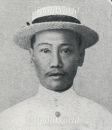We've tried to ensure the information displayed here is as accurate as possible. Should there be any inaccuracies, we would be grateful if you could let us know at info@ipohworld.org . All images and content are copyright.
(Please click on the thumbnail for a bigger image.)
Towkay Lam Look Ing

Lam Look Ing was one of the prominent residents of the mining town of Kampar, Perak, and the owner of several tin mines in the district of Kinta, employing about a couple of thousand men (Chinese). He was a native of San-Wui district, near Canton, China and was born and educated in Penang where his family have been well known and respected for many generations.
He proceeded to China when he was eighteen years old, and entered the Chinese Imperial naval arsenal at Foo Chow to learn navigation. He joined HICM ship Fei-Yuen as a midshipman, was promoted to gunner, and then lieutenant. At the time of Franco Chinese War he was transferred to Canton to take charge of a chartered steamer, Emuy, carrying ammunition and treasure over to Tam Sui, Formosa, where he rendered valuable service, in recognition of which he was created a Mandarin of the Blue Button and decorated with a peacock feather. When he retired an elder brother assumed the office.
In 1908, one of his brothers, Liu Kok Cheong, was in charge of the southern squadron.
Lam Look Ing became a large property owner in Ipoh and built the Lam Looking building which is situated close to the New Market in Laxamana Road (Jalan Laxamana).
Eugene Khoo kindly provided the following additional history:
"His name is pronounced as Lam Loke Ying. Born in Penang in 1863, Lam was a native of Xinhui, Guangdong. He received his early education in Penang, where his family was well-known and respected for many generations. At the age of 18, Lam proceeded to study at the Chinese Imperial Naval Arsenal at Fuzhou, majoring in sea navigation, and became a ship commander in the Franco-Chinese War. He retired his military service and was knighted with Mandarin of the Blue Button decorated with the Chinese Imperial official attire and a peacock feather headgear.
From China, Lam retired to Kampar and ventured into tin mining business and had contributed in the development of Chinese welfare and educations. He was awarded with Order of Merit with a gold medal presented by the Governor of Guangdong. His eldest son, Lam Weng Yoon was the president of Wah Seong Kok, the Literary Association of Kampar. While his second son Lam Weng Chak married Cheng Shaw Moiey, second daughter of Mr Cheng Oi Seng (Hong Kong).
Lam Weng Yoon's daughter Selena Lam was the first Asian woman to receive University of Queensland research grant. Selena completed her Bachelor of Science in University of Adelaide in 1959 and Master of Science in University of Queensland. She spent seven years in Australia for her studies and returned back to Malaya in 1963 posted as lecturer of bacteriology at University of Singapore.
In 1946, Lam Weng Chak was charged to the court for voluntarily caused hurt for the purpose of extorting confession. The offences were committed in March 1942, when Malaya was under Japanese Occupation.
In 1919, he bought Mess House of the Straits Trading Co. Ltd in Gopeng Road for $85,000. Lam's family residence was named as King's Villa at Gopeng Road, Ipoh. During his final two years, Lam's health was deteriorating and was treated at Singapore. On 1 June 1937 he died in Ipoh at the age of 74."
To see more rare photographs of Towkay Lam Look Ing and his official wife, click here.